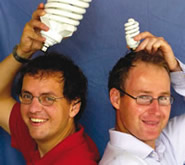Energy mad
A bright idea
Energy Mad evolved from a heated debate between the university friends. Mr Mackenzie had been reading a book about energy efficiency which said that if all New Zealanders installed energy efficient light bulbs there'd be no need for the now shelved Project Aqua. Amazed, Mr Mackenzie put the concept to Dr Mardon who vehemently disagreed – until he did a couple of calculations: "I discovered that Tom was right on the money," says Dr Mardon, "energy-efficient light bulbs are actually a very effective way of reducing peak network load and saving electricity. It certainly got us thinking."
Eighteen months, screeds of calculations and a business plan later, the friends became business partners. In 2004 Mr Mackenzie and Dr Mardon established Energy Mad with a vision of lessening the effects of climate change by increasing the nation's energy efficiency. Their first objective was "to get five energy-saving bulbs into 55 percent of homes in New Zealand". By doing so they hoped to save enough electricity to power a city as large as Dunedin, save domestic consumers money, and buy time for electricity transmission companies and suppliers.
But besides conviction, Energy Mad needed a good product. And so began a worldwide search for a suitable prototype; over 100 energy-saving bulbs were tested and the best, sourced from China, was selected for further development. "It was imperative that we undertook advanced development to meet New Zealand's specific consumer requirements," says Mr Mackenzie. "The demise of previous energy-efficient lighting campaigns had shown us that a non-customised bulb didn't cut it." To sell the product in New Zealand they had to ensure a good light output, compact size, attractive shape, long life, and switchability (tolerance of on/off switching). "Many of these features can only be achieved by customising a bulb to New Zealand's unique transmission conditions."

